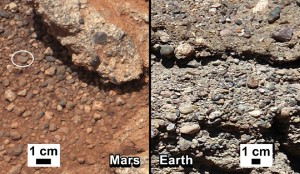By Alicia Chang
Associated Press
LOS ANGELES — The NASA rover Curiosity has beamed back pictures of bedrock that suggest a fast-moving stream, possibly waist-deep, once flowed on Mars — a find that the mission’s chief scientist called exciting.
There have been previous signs that water existed on the red planet long ago, but the images released Thursday showing pebbles rounded off, likely by water, offered the most convincing evidence so far of an ancient streambed.
There was “a vigorous flow on the surface of Mars,” said chief scientist John Grotzinger of the California Institute of Technology. “We’re really excited about this.”
The discovery did not come as a complete surprise. NASA decided to plunk Curiosity down inside Gale Crater near the Martian equator because photos from space hinted that the spot possessed a watery past. The six-wheeled rover safely landed Aug. 5 after a nail-biting plunge through the Martian atmosphere. It’s on a two-year, $2.5 billion mission to study whether the Martian environment could have been favorable for microbial life.
Present day Mars is a frozen desert with no hint of water on its radiation-scarred surface, but geological studies of rocks by previous missions suggest the planet was warmer and wetter once upon a time.
The latest evidence came from photos that Curiosity took revealing rounded pebbles and gravel — a sign that the rocks were transported long distances by water and smoothed out.
The size of the rocks — ranging from a sand grain to a golf ball — indicates that they could not have been carried by wind, said mission scientist Rebecca Williams of the Planetary Science Institute in Tucson, Ariz.
Though Curiosity did not use its high-tech instruments to drill into the rocks or analyze their chemical makeup, Grotzinger said scientists were sure that water played a role based on just studying the pictures.
It’s unclear how long the water persisted on the surface, but it easily could have lasted “thousands to millions of years,” said mission scientist Bill Dietrich of the University of California, Berkeley.
Curiosity chanced upon the dried-up streambed while driving to Glenelg, an intriguing spot where three types of terrain meet.
Its ultimate destination is Mount Sharp, a mountain rising from the center of crater floor, but it was not expected to travel there until the end of the year.
Finding past water is a first step toward learning whether the environment could have supported microbes. Scientists generally agree that besides water and an energy source such as the sun, organic carbon is a necessary prerequisite for life.
While an ancient streambed holds promise as a potentially habitable environment, scientists don’t think it’s a good place to preserve the carbon building blocks of life.
That’s why the rover will continue its trek to the foothills of Mount Sharp where there’s a better chance of finding organics.



